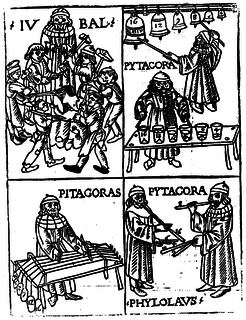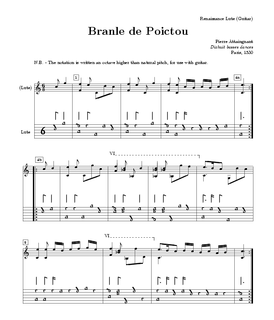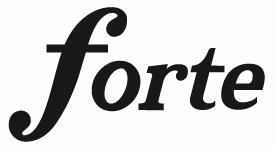GUIDO Music Notation is a computer music notation format designed to logically represent all aspects of music in a manner that is both computer-readable and easily readable by human beings. It was named after Guido of Arezzo, who pioneered today's conventional musical notation 1,000 years ago.
GUIDO was first designed by Holger H. Hoos (then at Technische Universität Darmstadt, Germany, now at University of British Columbia, Canada) and Keith Hamel (University of British Columbia, Canada). Later developments have been done by the SALIERI Project by Holger H. Hoos, Kai Renz and Jürgen F. Kilian. GUIDO Music Notation has been designed to represent music in a logical format (with the ability to render to sheet music), whereas LilyPond is more narrowly focused on typesetting sheet music.
- The basic idea behind the GUIDO design is representational adequacy which means that simple musical concepts are represented in a simple way and only complex notions require more complex representations.
GUIDO is not primarily focused on conventional music notation, but has been invented as an open format, capable of storing musical, structural, and notational information.
GUIDO Music Notation is designed as a flexible and easily extensible open standard. In particular, its syntax does not restrict the features it can represent. Thus, GUIDO can be easily adapted and customized to cover specialized musical concepts as might be required in the context of research projects in computational musicology. More importantly, GUIDO is designed in a way that when using such custom extensions, the resulting GUIDO data can still be processed by other applications that support GUIDO but are not aware of the custom extensions, which are gracefully ignored. This design also greatly facilitates the incremental implementation of GUIDO support in music software, which can speed up the software development process significantly, especially for research software and prototypes.
GUIDO has been split into three consecutive layers: Basic GUIDO introduces the main concepts of the GUIDO design and allows to represent much of the conventional music of today. Advanced GUIDO extends Basic GUIDO by adding exact score-formatting and some more advanced musical concepts. Finally, Extended GUIDO can represent user-defined extensions, like microtonal information or user defined pitch classes.

Music notation or musical notation is any system used to visually represent aurally perceived music played with instruments or sung by the human voice through the use of written, printed, or otherwise-produced symbols, including notation for durations of absence of sound such as rests.
In computer science, pseudocode is a plain language description of the steps in an algorithm or another system. Pseudocode often uses structural conventions of a normal programming language, but is intended for human reading rather than machine reading. It typically omits details that are essential for machine understanding of the algorithm, such as variable declarations and language-specific code. The programming language is augmented with natural language description details, where convenient, or with compact mathematical notation. The purpose of using pseudocode is that it is easier for people to understand than conventional programming language code, and that it is an efficient and environment-independent description of the key principles of an algorithm. It is commonly used in textbooks and scientific publications to document algorithms and in planning of software and other algorithms.
In Western musical notation, the staff (US) or stave (UK) is a set of five horizontal lines and four spaces that each represent a different musical pitch or in the case of a percussion staff, different percussion instruments. Appropriate music symbols, depending on the intended effect, are placed on the staff according to their corresponding pitch or function. Musical notes are placed by pitch, percussion notes are placed by instrument, and rests and other symbols are placed by convention.

Music theory is the study of the practices and possibilities of music. The Oxford Companion to Music describes three interrelated uses of the term "music theory". The first is the "rudiments", that are needed to understand music notation ; the second is learning scholars' views on music from antiquity to the present; the third a sub-topic of musicology that "seeks to define processes and general principles in music". The musicological approach to theory differs from music analysis "in that it takes as its starting-point not the individual work or performance but the fundamental materials from which it is built."
Sheet music is a handwritten or printed form of musical notation that uses musical symbols to indicate the pitches, rhythms, or chords of a song or instrumental musical piece. Like its analogs – printed books or pamphlets in English, Arabic, or other languages – the medium of sheet music typically is paper, although the access to musical notation since the 1980s has included the presentation of musical notation on computer screens and the development of scorewriter computer programs that can notate a song or piece electronically, and, in some cases, "play back" the notated music using a synthesizer or virtual instruments.

LilyPond is a computer program and file format for music engraving. One of LilyPond's major goals is to produce scores that are engraved with traditional layout rules, reflecting the era when scores were engraved by hand.

A scorewriter, or music notation program is software used with a computer for creating, editing and printing sheet music. A scorewriter is to music notation what a word processor is to text, in that they typically provide flexible editing and automatic layout, and produce high-quality printed results.

Braille music is a braille code that allows music to be notated using braille cells so music can be read by visually impaired musicians. The system was incepted by Louis Braille.

Music engraving is the art of drawing music notation at high quality for the purpose of mechanical reproduction. The term music copying is almost equivalent—though music engraving implies a higher degree of skill and quality, usually for publication. The name of the process originates in plate engraving, a widely used technique dating from the late sixteenth century. The term engraving is now used to refer to any high-quality method of drawing music notation, particularly on a computer or by hand.
The numbered musical notation, is a musical notation system widely used in music publications in China. It dates back to the system designed by Pierre Galin, known as Galin-Paris-Chevé system. It is comparable to the Gongche notation from the Tang Dynasty.

A neume is the basic element of Western and Eastern systems of musical notation prior to the invention of five-line staff notation.

In Medieval music, the Guidonian hand was a mnemonic device used to assist singers in learning to sight-sing. Some form of the device may have been used by Guido of Arezzo, a medieval music theorist who wrote a number of treatises, including one instructing singers in sightreading. The hand occurs in some manuscripts before Guido's time as a tool to find the semitone; it does not have the depicted form until the 12th century. Sigebertus Gemblacensis in c. 1105–1010 did describe Guido using the joints of the hand to aid in teaching his hexachord. The Guidonian hand is closely linked with Guido's new ideas about how to learn music, including the use of hexachords, and the first known Western use of solfège.
Optical Music Recognition (OMR) is a field of research that investigates how to computationally read music notation in documents. The goal of OMR is to teach the computer to read and interpret sheet music and produce a machine-readable version of the written music score. Once captured digitally, the music can be saved in commonly used file formats, e.g. MIDI and MusicXML.
ABC notation is a shorthand form of musical notation. In basic form it uses the letters A through G, letter notation, to represent the given notes, with other elements used to place added value on these – sharp, flat, the length of the note, key, ornamentation. This form of notation began as an ASCII character set code that could facilitate the sharing of music online and also added a new and simple language for software developers, not unlike other notations designed for ease, such as tablature and solfège. The earlier ABC notation was built on, standardized, and changed to better fit the keyboard and an ASCII character set by Chris Walshaw, with the help and input of others. Originally designed for use with folk and traditional tunes of Western European origin, e.g., English, Irish, Scottish, which are typically single-voice melodies that can be written on a single staff in standard notation, the work of Chris Walshaw and others has opened this up with an increased list of characters and headers in a syntax that can also support metadata for each tune.
Holger H. Hoos is a German-Canadian computer scientist and a professor of machine learning at Leiden University. He is also an adjunct professor at the Computer Science Department of the University of British Columbia, where he held a full-time professorial appointment from 2000 until 2016. His research interests are focused on empirical algorithmics with applications in artificial intelligence, bioinformatics and operations research. In particular, he works on automated algorithm design and on stochastic local search algorithms. Since 2015, he is a Fellow of the Association for the Advancement of Artificial Intelligence (AAAI), and since 2020 a Fellow of the European Association for Artificial Intelligence (EurAI) as well as a Fellow of the Association for Computing Machinery (ACM).
The Music Encoding Initiative (MEI) is an open-source effort to create a system for representation of musical documents in a machine-readable structure. MEI closely mirrors work done by text scholars in the Text Encoding Initiative (TEI) and while the two encoding initiatives are not formally related, they share many common characteristics and development practices. The term "MEI", like "TEI", describes the governing organization and the markup language. The MEI community solicits input and development directions from specialists in various music research communities, including technologists, librarians, historians, and theorists in a common effort to discuss and define best practices for representing a broad range of musical documents and structures. The results of these discussions are then formalized into the MEI schema, a core set of rules for recording physical and intellectual characteristics of music notation documents. This schema is expressed in an XML Schema Language, with RelaxNG being the preferred format. The MEI schema is developed using the One-Document-Does-it-all (ODD) format, a literate programming XML format developed by the Text Encoding Initiative.
Computational musicology is an interdisciplinary research area between musicology and computer science. Computational musicology includes any disciplines that use computers in order to study music. It includes sub-disciplines such as mathematical music theory, computer music, systematic musicology, music information retrieval, computational musicology, digital musicology, sound and music computing, and music informatics. As this area of research is defined by the tools that it uses and its subject matter, research in computational musicology intersects with both the humanities and the sciences. The use of computers in order to study and analyze music generally began in the 1960s, although musicians have been using computers to assist them in the composition of music beginning in the 1950s. Today, computational musicology encompasses a wide range of research topics dealing with the multiple ways music can be represented.

MusiXTeX is a suite of open source music engraving macros and fonts that allow music typesetting in TeX.

Forte is a music notation program developed by the German company Lugert Verlag, located in Handorf. Its name is derived from the dynamic marking of forte. The program is available in both German and English.










